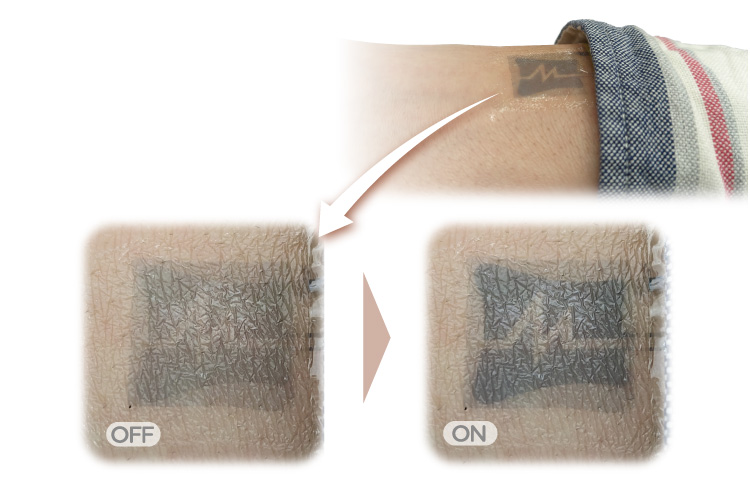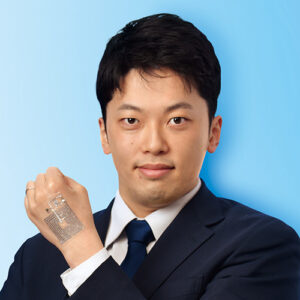Developing Soft Electronics
A Young Frontrunner Defying Conventional Notions in The Field of Electronics

Our lives are surrounded by several electronic devices, such as smartphones, PCs, and dazzling digital billboards. Most people do not question the conventional school of thought that such devices are meant to be rigid. However, Associate Professor Naoji Matsuhisa of UTokyo-IIS has challenged this thought and seeks to develop soft and stretchable electronics.
A Future Forged by Soft Wearable Devices
Wearable devices have gained a lot of attention as extended applications of flexible electronics.
Currently, wearable devices such as smart watches are becoming increasingly popular. Data that could only be obtained once a week or once a month previously, can now be obtained 24 hours a day. The obtained data can facilitate the detection of diseases such as atrial fibrillation and Alzheimer’s disease at early stages with high accuracy. However, as the benefits of wearable devices are becoming increasingly apparent, so too is a major barrier to their adoption, i.e., their “rigidity.” There are only a limited number of locations on the body where rigid devices can be placed, such as the wrists, fingers, and ears. Furthermore, many people may feel uncomfortable wearing such devices.
A soft wearable device that has the same mechanical properties as that of the skin, can stick to the body surface, significantly reducing discomfort. It is expected that even those who struggle to understand the implications of wearing such devices, such as babies and people with dementia, will be able to wear them without discomfort.
Another key advantage is improved adhesion to the skin, which can dramatically improve the quality of the bio-signals that the device acquires. Soft electronic devices can conform to small wrinkles of the skin, resulting in a large contacting surface area between the device and the skin. A larger contact area results in a stronger adhesive force, which in turn increases the device’s ability to track the movements of the skin surface. This will significantly reduce the signal noise caused by exercise and other activities.
The COVID-19 pandemic has stressed, yet again, the importance of at-home medical care. As the population continues to age, it is expected that the number of people who will have difficulties visiting medical institutions will also increase. This will also increase the number of locations where medical care cannot be secured. Hence, soft wearable devices are expected to become increasingly important in the future, as the demand for high-precision healthcare monitoring and reduced burden on medical staff increases.

Image: Naoji Matsuhisa Laboratory
Progressive Utilization in the Field of Robotics
Stretchable electronics will potentially also play an active role in the field of robotics.
Soft robots are new types of robots that are mechanically as soft as humans or animals. This kind of technology may also play a significant role at disaster sites. Unlike factory robots that handle parts with a fixed shape, robots at disaster sites require adaptable responses, such as grabbing debris and waste, turning valves and levers, or lifting injured people. Arms made of soft and stretchable materials are able to grab objects adaptively and gently. The installation of a soft sensor on the robotic hand surface will enable the robot to determine the hardness and the texture of the object that needs to be grabbed. This will allow it to gauge important information, such as the amount of grip strength required.
Revolutionizing How Electronics and Humans Connect
Associate Professor Matsuhisa is also exploring novel ways to bring joy to people using soft electronic devices.
“We are currently developing a display that adheres to the skin, which we think can be used for applications such as digital makeup. It will have the ability to automatically adjust its color according to the brightness of its surroundings, or create facial expressions, such as when one is nervous. We are unsure if it will be useful, but we hope that people will find it amusing. If we actually succeed in attaching these devices, high-performance biosensors can be installed together. Such devices can obtain high-accuracy biometric information and lead to social impact on a large scale.”

Photograph: Naoji Matsuhisa Laboratory
A display that adheres to skin wrinkles (under development). The color becomes darker when the power supply is turned on.
Matsuhisa has indicated that soft electronics, which defy the conventional idea that electronics must be hard, have the potential to change the very way that people view electronics.
“For example, people may feel like hugging stuffed animals because they are soft, but they may not feel the same way toward a hard PC. People perceive rigid devices to be cold and non-living and cannot help but consider them as foreign objects. However, we believe that when electronic devices become soft, just like living things, then we will develop a sense of familiarity toward them, just like we do toward stuffed toys. We believe that such feelings will change our relationship with computers, how we connect with electronics, and how we think about the data obtained from electronics.”
Wide-Ranging Research, from Basic to Applied Research: Forging the Future of Stretchable Electronics
Due to the collaborative research he has conducted with researchers across various fields, Matsuhisa has presented a variety of results that are not limited to a single field. What he prioritizes most in collaborative research is for his collaborators to feel a mutual bond and sense of connectedness with each other.
“I feel that a strong human bond and the desire to conduct research specifically with another person leads to great results. When I was a post-doctoral researcher at Stanford University, I became good friends with a battery researcher at a house party. The joint research we conducted afterwards led to research on stretchable lithium-ion batteries.”
Matsuhisa conducts a variety of research that ranges from the development of basic materials to the construction of devices with full-scale practical applications. The following are research topics that he is currently working on.
“Semiconductors are usually hard silicon materials, but flexible semiconductors have recently been put to practical use. Ever since then, we have developed next-generation semiconductors that are stretchable, and are focusing on the development of electronic devices that utilize these semiconductors.
“Another topic is the development of electronic devices that one would not even perceive upon seeing or touching. We are applying a special fabrication process that integrates with the skin to create a device that feels like it isn’t there but is actually there.”
Matsuhisa’s policy is to use any material as long as it stretches. He spoke about his desire to further develop stretchable electronics. He adds, “For example, inorganic materials are highly stable, but not soft. Meanwhile, organic materials have limited stability. Achieving stretchable electronics requires using the right materials in the right place. Hence, we would be interested in using a variety of materials.”
Tokihiko Shimura, Shun Sato, Peter Zalar and Naoji Matsuhisa”Engineering the Comfort-of-Wear for Next Generation Wearables”Advanced Electronic Materials (2022),
DOI: 10.1002/aelm.202200512

Featured Researcher
Naoji Matsuhisa
(Associate Professor, Institute of Industrial Science, The University of Tokyo)
Special Field of Study: Interactive electronic devices
This article was originally published in the UTokyo-IIS Bulletin, an English-language magazine that introduces the activities of UTokyo-IIS.
> Publications



Comments
No comments yet.
Join by voting
How did you feel about the "Possible Future" depicted in this article? Vote on your expectations!
Please visit the laboratory website if you would like to learn more about this article.
Share